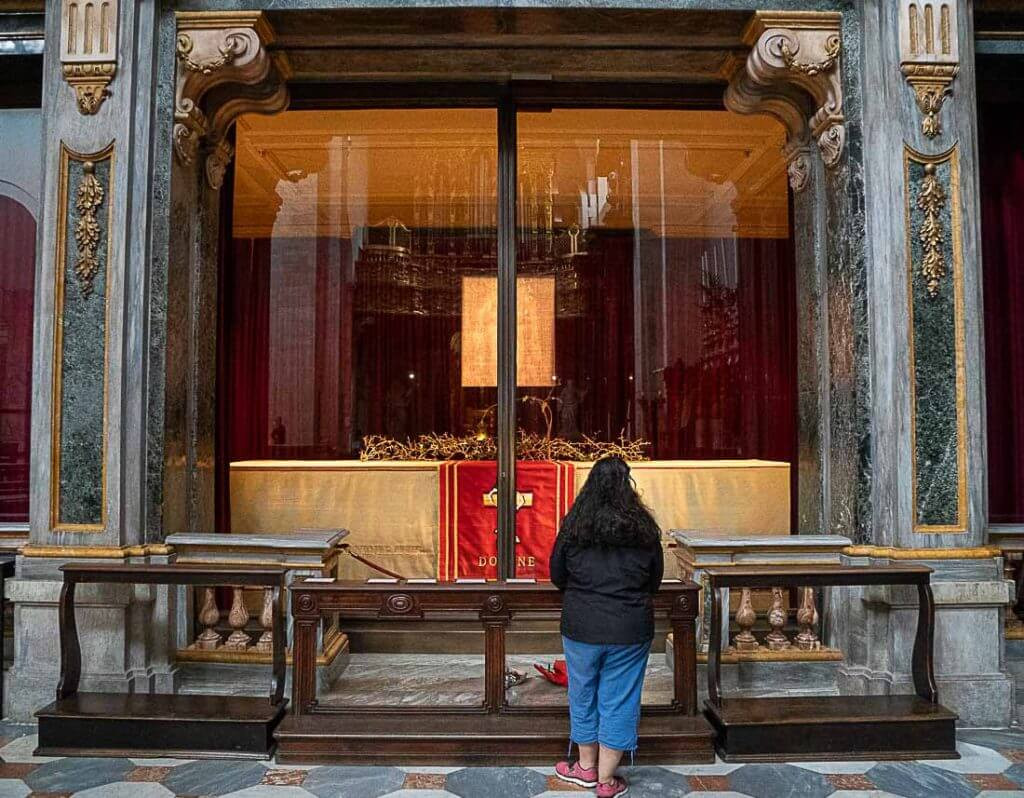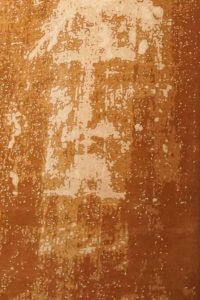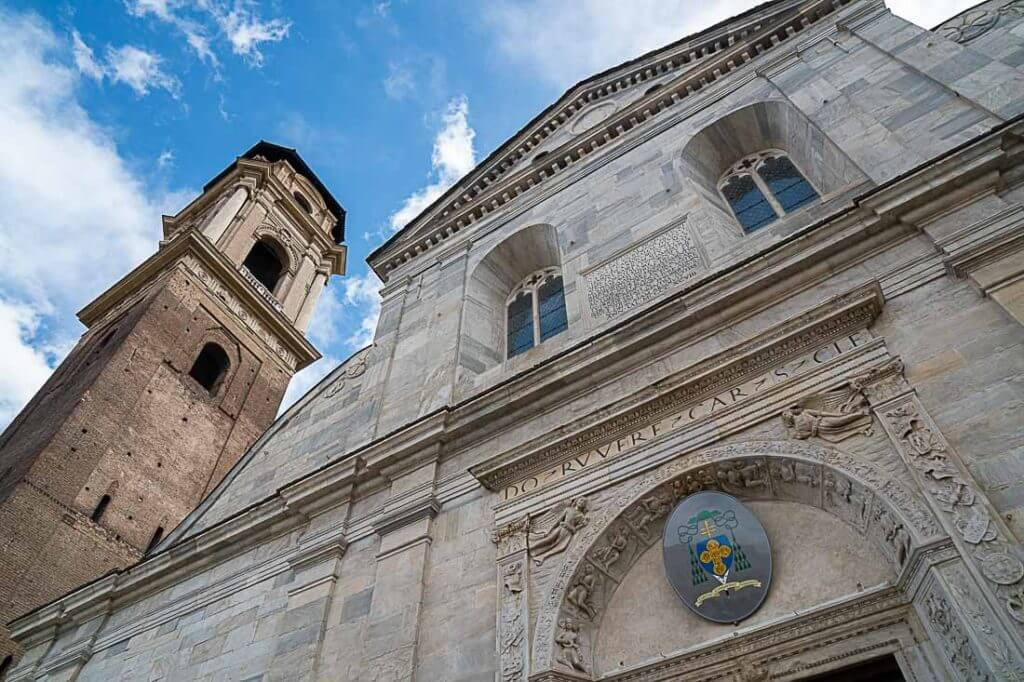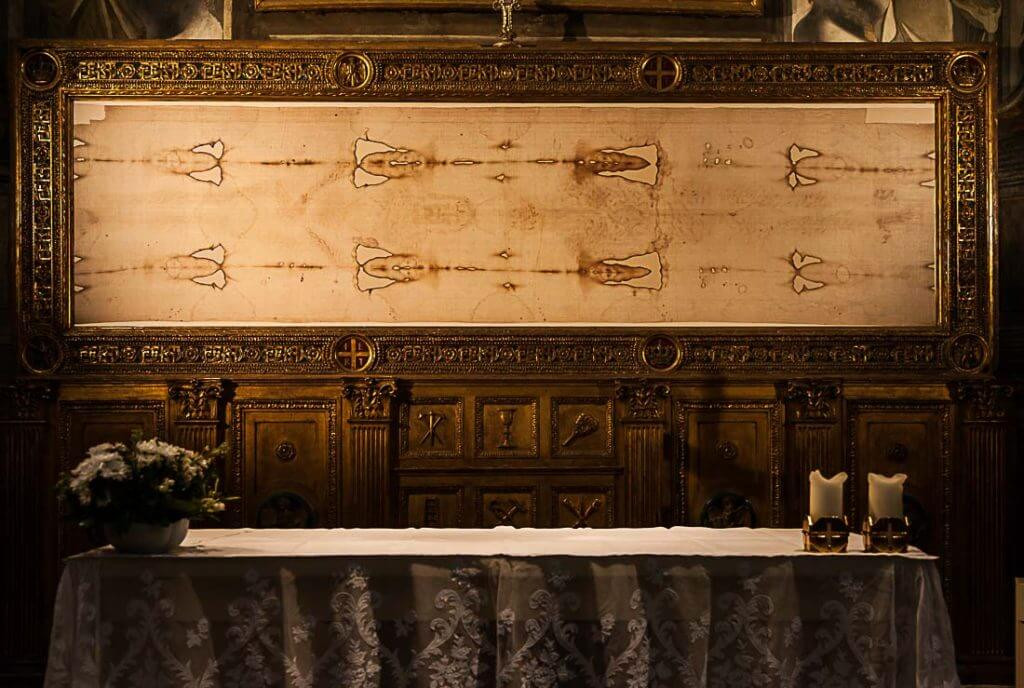The Vatican’s recent announcement of a public display of the Holy Shroud in 2025 has reignited global interest in this enigmatic artifact. Located in Turin, Italy, the Shroud of Turin, also known as the Jesus Shroud, is considered by many within the Catholic Church and beyond to be the burial cloth of Jesus Christ.
Having visited the Chapel of the Holy Shroud in Turin numerous times, I want to offer you a comprehensive guide to this significant relic. Whether you are a devout Catholic or simply an inquisitive traveler, the Jesus Shroud stands as one of Turin’s most compelling attractions, likely to be on your list when exploring this captivating Italian city.
Perhaps you’ve heard of the Shroud of Turin but remain uncertain about the facts and fictions surrounding it. You’re not alone. This piece of cloth is steeped in mystery and controversy, sparking debate and fascination for centuries.
 Visitors gaze upon the Shroud of Turin, a revered religious artifact displayed in the Chapel of the Holy Shroud, Turin Cathedral, Italy, attracting global interest.
Visitors gaze upon the Shroud of Turin, a revered religious artifact displayed in the Chapel of the Holy Shroud, Turin Cathedral, Italy, attracting global interest.
The Turin Shroud captivates visitors worldwide, drawn to its history and mystery.
Unveiling the Turin Shroud: Facts and Key Information
References to Jesus’ burial shroud appear in ancient narratives and religious texts, and discussions regarding its authenticity frequently surface in contemporary news. It’s understandable if you find yourself perplexed amidst the ongoing debate. My aim here is to clarify the truths from the myths, providing you with essential information to appreciate the Holy Shroud during your visit to Turin, Italy.
Join me as we delve into the intriguing facts surrounding the Shroud of Turin, exploring its nature, the question of its reality, its precise location, visual representations, and practical guidance on how to experience it firsthand.
What Exactly is the Shroud of Turin?
The Turin Shroud is a linen cloth of considerable size, measuring approximately 4.41 meters in length and 1.13 meters in width.
Upon this fabric is a faint brownish imprint that bears a striking resemblance to the body image of a naked man, depicted both front and back, with his hands positioned across the groin area. Many interpret these markings, along with apparent bloodstains, as originating from the crucified body of Jesus Christ.
The image on the shroud becomes remarkably clearer when viewed as a photographic negative.
For some, it is unequivocally the Jesus Shroud – the authentic burial cloth that enveloped Christ’s body after the crucifixion. For others, its significance lies in its symbolic representation, serving as a powerful religious metaphor embodying the narrative of Christ’s Passion.
Regardless of interpretation, the shroud undeniably remains a potent symbol for Christians across the globe. During each of my visits, I’ve witnessed countless individuals immersed in prayer, contemplation, and reflection, attempting to grasp the profound significance held within this artifact.
Powered by GetYourGuide
The Historical Timeline: When Was the Shroud of Turin First Documented?
The earliest verifiable historical record of the Turin Shroud dates back to the 1350s. It is documented that Geoffroi de Charny, a French knight, approached church officials in Lirey, France, presenting the cloth as the true shroud of Jesus.
Intriguingly, historical records are silent regarding the knight’s acquisition of the shroud or its whereabouts before the 14th century. This absence of prior history fuels the enduring mystery surrounding the cloth, prompting speculation about its undocumented journey during the 1300 years between Christ’s burial and its reappearance in historical records.
 Artistic depiction of Jesus Christ, commonly used for illustrative purposes in religious contexts.
Artistic depiction of Jesus Christ, commonly used for illustrative purposes in religious contexts.
The Pivotal Question: Is the Shroud of Turin Authentically the Burial Cloth of Jesus?
The question of the Shroud of Turin’s authenticity is undeniably central to its intrigue. Is the Shroud of Turin real?
The answer, unfortunately, is not straightforward.
A significant moment in the shroud’s modern history occurred in 1898 when Secondo Pia, an amateur Italian photographer, captured the first photograph of the artifact. Pia anticipated a blurred negative image of a face in his photograph. Instead, he was astonished to discover a strikingly clear positive image on his photographic plate. This revelation implied that the image on the Shroud itself was, in effect, a negative – a photographic inversion of light and dark.
This discovery was groundbreaking. It presented strong evidence against the theory that the shroud was merely a painting. Artists before 1898 would have lacked the understanding and techniques to create a detailed negative image, especially one with such nuanced detail.
However, scientific scrutiny continued. In 1988, a team of scientists conducted radiocarbon dating on samples from the shroud to determine its age. The results indicated that the linen dated back to the 13th century, specifically between A.D. 1260 and 1390.
These findings presented a significant challenge to the shroud’s authenticity as the burial of Jesus is traditionally placed around A.D. 33. The carbon dating results seemed to suggest the shroud originated over a millennium after Christ’s death.
However, the 1988 carbon dating study has faced subsequent scrutiny and challenges. Researchers have raised concerns about the reliability of the radiocarbon dating results due to potential contamination and the nature of the samples tested.
Proponents who argue for the shroud’s authenticity suggest that centuries of damage, including a significant fire in 1532, could have compromised the artifact’s material. They propose that this accumulated damage makes accurate dating through radiocarbon methods exceedingly difficult, if not impossible.
Powered by GetYourGuide
DNA Analysis: Seeking Biological Clues from the Shroud of Turin
In the ongoing quest to determine the Shroud of Turin’s true nature, scientists have employed DNA testing to shed further light on its origins and history. These analyses have focused on both human and non-human DNA found on the shroud’s fibers.
The DNA results revealed a fascinating aspect of the shroud’s history: it had been handled by people from diverse geographical regions. However, in terms of definitively proving or disproving the shroud’s authenticity as the burial cloth of Jesus, the DNA results have not provided conclusive answers. Instead, they have deepened the enigma surrounding the shroud, suggesting a rich and complex history of travel and contact since its documented appearance in the 1350s.
X-Ray Dating: A New Scientific Perspective on the Shroud’s Age
Despite the widespread belief among millions that the body image on the shroud is that of Jesus Christ, scientific investigation has remained relentless.
The most recent scientific study, conducted in 2022, was led by Italian scientist Liberato De Caro. This research employed a cutting-edge technique known as Wide-Angle X-ray Scattering (WAXS). The analysis focused on a minute thread, measuring just 0.5 mm × 1 mm, taken from the feet area of the frontal image on the shroud.
The outcome of this advanced testing?
The X-ray analysis indicated that the Shroud of Turin is significantly older than suggested by the earlier carbon dating tests. The WAXS analysis dated the linen to approximately 2000 years of human history, a timeframe that aligns with the period when Jesus was buried.
Ultimately, whether you choose to believe in the Shroud of Turin’s authenticity remains a matter of personal conviction and interpretation, informed by both faith and scientific inquiry.
Deciphering the Name: Why is it Called the Shroud of Turin?
While historical mentions trace the artifact back to 6th-century Lirey, France, the question arises: why is it known as the Shroud of Turin, named after a city in Northern Italy?
The name is directly linked to the shroud’s current and long-term location.
 The Turin Cathedral, officially the Cathedral of Saint John the Baptist, the current location of the Shroud of Turin in Italy.
The Turin Cathedral, officially the Cathedral of Saint John the Baptist, the current location of the Shroud of Turin in Italy.
The Shroud of Turin is enshrined within the Cathedral of St. John the Baptist, also known as Turin Cathedral.
Precisely Where is the Shroud of Turin Located?
The Jesus Shroud has been housed within the Cathedral of St. John the Baptist in Turin, Italy, since the 16th century (specifically, 1578). This cathedral, also referred to as Turin Cathedral, is a sacred site serving as the seat of the Archbishops of Turin and is dedicated to Saint John the Baptist. For an in-depth exploration, we have a dedicated article focusing on the Turin Shroud Location and the details of the Chapel that houses it.
The cathedral’s location is conveniently adjacent to the Turin Royal Palace, placing it right in the heart of the city center. You might easily pass by it without realizing that the Holy Shroud is preserved within its walls.
Is a Visit to the Cloth of Jesus Worthwhile?
The intriguing facts and ongoing controversies surrounding the Shroud of Turin, a truly unique artifact, are compelling reasons to visit, at least in my perspective.
Given the conflicting results from scientific tests and research, the answer to the question of its authenticity ultimately rests on your own interpretation and belief.
Regardless of your personal faith or religious background, the Shroud of Turin represents a significant piece of history. A visit to witness the Shroud and its chapel is undoubtedly worthwhile for anyone seeking to learn more about this enduring enigma.
You might also find this Web Story about the Shroud of Turin engaging.
Practicalities: How to Visit the Turin Shroud
If your travel plans include Turin or the surrounding region, a visit to the Turin Cathedral, the repository of the Holy Shroud, is highly recommended.
It is important to note that the original cloth is not typically on public display. Due to its fragile condition, the shroud is maintained in a protected environment and is not regularly exhibited to the general public. It is safeguarded behind bulletproof glass and monitored by security systems. Visitors can access the chapel where it is securely stored and view a detailed replica of the shroud.
A frequently asked question is whether the Shroud of Turin is viewable on special occasions. The encouraging news is that opportunities to see the actual shroud do arise. If you are planning a trip to Turin in 2025, you may have a chance to witness the real shroud in person.
The Pope has announced a potential public display of the Shroud of Turin in 2025, coinciding with the Jubilee Year. While specific dates are yet to be confirmed by the Vatican, announcements are anticipated soon.
Previous rare exhibitions of the Turin Shroud occurred in 2000, 2010, and 2015. If a display takes place in 2025 (or possibly 2026), it will be a major event for both the Christian community and the city of Turin. If you intend to visit Turin, it is advisable to plan your trip once the Vatican officially announces the dates for the public viewing.
 Close-up detail of a replica of the Holy Shroud of Turin, exhibited in Italy.
Close-up detail of a replica of the Holy Shroud of Turin, exhibited in Italy.
Detail of a copy of the Holy Shroud of Turin, Italy, providing a close representation of the artifact.
Expanding Your Exploration: The Holy Shroud Museum
If your travel plans don’t align with the 2025 public display, or if simply viewing the Shroud Chapel leaves you wanting more, there’s a dedicated institution where you can delve deeper into the shroud’s history and mysteries.
The Most Holy Shroud Museum, known in Italian as Il Museo de La Sindone, is the ideal destination. This museum offers a wealth of information about the shroud’s captivating history, its numerous enigmas, detailed replicas, and compelling exhibits related to the artifact.
After visiting the Cathedral, a short 10-minute walk will bring you to the museum.
It’s important to distinguish this museum from another nearby institution. The Museo Diocesano di Torino, located adjacent to the Turin Cathedral, is a museum of diocesan art and sacred objects, which includes access to the bell tower with views of the Palatine Gate (Porta Palatina) and the Royal Palace. While interesting, it is not focused on the Shroud itself.
For a more immersive experience, consider joining a private guided tour that will lead you through the historical narrative of the Turin Shroud, encompassing visits to both the museum and the cathedral. This offers a unique and enriching way to engage with the subject. You can book a Private Tour on The Path of The Holy Shroud in Turin here.
Powered by GetYourGuide
Accommodation Options: Where to Stay in Turin for Visiting the Holy Shroud
If your primary focus in Turin is the Shroud, choosing accommodation near the cathedral and museum will allow you to fully immerse yourself in the city’s historical and religious atmosphere.
Turin offers a variety of excellent lodging options. You can consult our comprehensive guide on where to stay in Turin here. However, to assist you in your planning, I’ve selected a few top recommendations for hotels conveniently located for exploring the Holy Shroud:
NH Collection Torino Santo Stefano
The NH Torino Santo Stefano Hotel is exceptionally located, just 150 meters from Turin Cathedral. It’s an ideal choice for those wishing to be in the heart of the Quadrilatero Romano district and within easy reach of all major city attractions. This prestigious 4-star hotel offers spacious rooms, a complimentary breakfast, and a rooftop terrace boasting panoramic city views.
Reserve your stay at NH Torino Santo Stefano by clicking here!
Combo Torino
Combo Torino provides an excellent option for travelers seeking a social atmosphere or budget-conscious accommodations. This hostel offers modern private rooms and dormitory options (mixed and female-only). Its central location is directly opposite the Porta Palazzo market and a short walk from both Turin Cathedral and the Royal Palace. The hostel features spacious and clean rooms and bathrooms, a communal kitchen, a pleasant restaurant/bar, and hosts regular cultural events.
Explore rates and room availability at Combo Turin Hostel here!
Hotel Diplomatic
Hotel Diplomatic offers a substantial breakfast buffet and a convenient location a 10-minute walk from Porta Susa train station, ideal if you are arriving in Turin by high-speed train. This makes it a practical base for exploring the city, with Turin Cathedral easily accessible via a 13-minute tram ride or a 21-minute walk.
Check room rates and availability at Hotel Diplomatic!
Turin Travel Essentials
Now that you are informed about the location of the Shroud of Turin, how to visit, and where to stay, here are some additional tips for your Turin trip.
Turin is a true gem within Italy. As the capital of the Piedmont region, it boasts a rich royal heritage, evident in the Turin Royal Palace and Royal Armory and the 7 Royal Palaces and Residences designated as UNESCO World Heritage Sites. It is also recognized as the Italian Capital of Chocolate and houses one of the world’s largest Egyptian Museums.
My affection for Turin has led me to write extensively about what makes it such a compelling travel destination. Explore 11 Reasons to Visit Turin this year and a comprehensive guide with 27 Things to do in Turin, compiled with local insights for trustworthy recommendations.
Whether your visit to Turin is driven by Christian faith, curiosity about the Holy Shroud, or a combination of both, I am confident you will find this remarkable city as captivating as I do.
